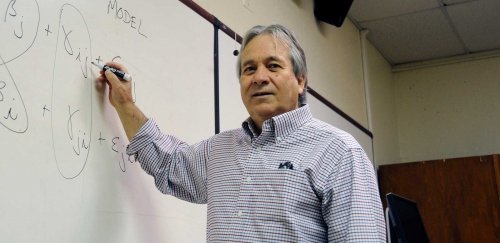International Researchers Tap Statistics Expert Tom Malloy
- News & Events
- News
- International Researchers Tap Statistics Expert Tom Malloy

RIC Professor of Psychology Thomas Malloy specializes in advanced statistical methods, which, to the untrained eye, look like a mass of charts, graphs and odd-looking formulas.
In fact, “statistical methods are used to make rational decisions about what data reveal,” said Malloy. “Research methods and statistics are alternatives to acquiring knowledge unsystematically or irrationally.”
Malloy’s command of statistics has captured the attention of international researchers in Ireland, England, Finland and, now, Jerusalem, who have requested that he collaborate with them on their research projects.
From Aug. 9-11 he will be at The Hebrew University of Jerusalem’s School of Business, where he will present a two-hour lecture on a statistical method called the social relations model. He will lead a two-hour software training to conduct social relations analyses and collaborate with Professor Avraham Kluger and his School of Business graduate students to design new research based on the model.
Malloy described the social relations model as a method of determining what occurs when two people interact. “It’s unique in the field of psychology,” he said, “because, traditionally, the focus in psychology has been on individuals. Rarely have researchers looked at dyads [two people interacting]. The social relations model allows researchers to statistically represent behavior in a dyad.”
Kluger and his students are researching the quality of listening in dyadic interactions. Malloy will work with them in their lab to design new listening studies using the social relations model. This collaboration is expected to continue for six months.
Simultaneously, Malloy is collaborating with researchers at Ulster University in Northern Ireland and Edge Hill University in Englandon face-to-face dyadic interaction using the social relations model.
And on Aug. 12 Malloy flies to Berlin, where he will meet with a group of scientists to discuss one of the largest studies on human development that has ever been conducted – the 1987 Finnish Birth Cohort Study, sponsored by the Finnish National Institute for Health and Welfare. More than 60,000 people are represented in this study, which is every person born in Finland in 1987. Members of the study have been followed for 25 years.
Malloy will act as a consultant, providing his expertise on structural equation modeling, another advanced statistical method. The lead in the research study is RIC alumna Tiina Ristikari of Finland, a senior scientist at the Finnish National Institute for Health and Welfare.
A graduate of the Class of 2003, Ristikari’s honors thesis was directed by Malloy and based on the social relations model. Years later, Malloy and Ristikari reconnected and began planning the first set of analyses for the 1987 Finnish Birth Cohort Study.
From Aug. 12-15 Malloy will meet with Ristikari and other scientists from Denmark and Finland to plan new analyses of the 1987 Finnish Birth Cohort Study.
Malloy remarked that he feels “privileged” to have been invited to collaborate on these international research projects.
“That I am sought as a methodologist by international research teams is a testament to the outstanding training in methods and statistics I received,” he said. “I had the good fortune of working with leading methodologists. In particular, Professor David Kenny at the University of Connecticut, who developed methods to statistically model processes that occur when two people interact. He also introduced structural equation modeling to the field of psychology in his seminal book ‘Correlation and Causality.’ Being his graduate student put me on this path. As a professor, I feel an obligation to share my expertise with others.”
Malloy is also conducting his own research on visual attention to faces of in-group and out-group members, funded by RI-INBRE and the National Institute of General Medical Sciences, a component of the National Institutes of Health. And he directs the Intergroup Relations Laboratory at Rhode Island College.
